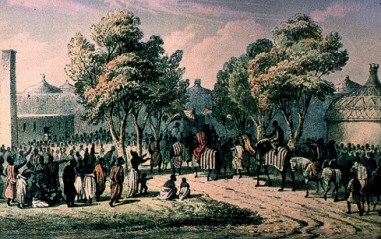The Kanem-Bornu Empire was a large African state which existed from the 9th century through the end of the 19th century and which spanned a region which today includes the modern-day countries of Niger, Chad, Cameroon, and Nigeria. The empire was founded by the Zaghawa nomadic people, who may have been the first in the central Sudan to acquire and make use of iron technology and horses.
The empire was first mentioned by Arab chroniclers in the 9th century, and by the 10th century the ruler of Kanem had control of the Kawar Oases, a vital economic asset. The political structure of the Kanem empire had most likely grown out of rival states coming under the control of the Zaghawa. In the 11th century the Zaghawa clans were driven out by Humai ibn Salamna, who founded the kingdom of Kanem with a capital at Njimi. The Saifwa dynasty was established, a dynasty which ruled for 771 years—the longest known reign in history. Saifwa rulers (known as mais) claimed they were descended from a heroic Arabic figure, and the dynasty greatly expanded the influence of Islam, making it the religion of the court. Wealth came largely through trade, especially in slaves, which was facilitated by the empire’s position near important North-South trade routes.
The empire had a policy of imperial expansion and traded for firearms and horses, wielding huge numbers of cavalry. When a mai desecrated a sacred animist religious artifact, conflict occurred between the dynasty and groups like the Bulala. Conflicts from outside forces were also enhanced by the empire’s policy of collateral succession of brother succeeding brother which produced short reigns and unstable situations. In the late 14th century the Saifawa were forced to retreat west across Lake Chad and establish a new kingdom called Bornu. This is the origin of the name Kanem-Bornu.
Bornu expanded territorially and commercially, but increasing threats from other rival states, drought, trade problems, and rebellious Fulani groups eroded state control. Muhammad al-Amin al-Kanemi, a Muslim cleric, eventually defeated the rebellious Fulani and built a new capitol at Kukawa in 1814. His successors ended the Saifwa dynasty and the Kanem-Bornu Empire when they killed the last mai in 1846. Al-Kanemi’s Shehu dynasty was short-lived, and succeeded by slaver and warlord Rabih Zubayr, who was defeated by the French in 1900.


